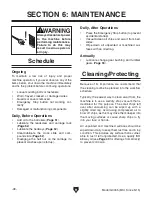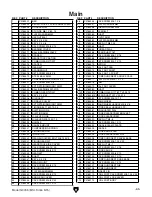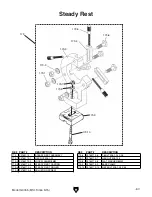
Model G0765 (Mfd. Since 5/15)
-55-
Gib Adjustment
The goal of adjusting the gib screws is to remove
sloppiness or "play" from the ways without over-
adjusting them to the point where they become
stiff and difficult to move.
In general, loose gibs cause poor finishes and
tool chatter; however, over-tightened gibs cause
premature wear and make it difficult to turn the
handwheels.
3. Adjust all three cap screws in small and equal
increments, then test movement of slide by
rotating handwheel.
Note: Turning cap screws clockwise tightens
the gib, and turning them counterclockwise
loosens the gib.
4. When satisfied with gib adjustment, use hex
wrench to prevent cap screws from moving,
then retighten hex nuts to secure the settings.
5. Recheck movement of slide and, if neces-
sary, repeat
Steps 2–4.
Figure 83. Compound slide gib adjustment hex
nuts and cap screws.
The gib adjustment process usually requires some
trial-and-error. Repeat the process as necessary
until you find the best balance between loose and
stiff movement. Most machinists find that the ideal
gib adjustment is one where a small amount of
drag or resistance is present, yet the handwheels
are still somewhat easy to move.
Clean and lubricate the ways before beginning
any adjustments. Refer to
Lubrication on Page
51 for instructions and lubricant specifications.
Tools Needed
Qty
Open-End Wrench 7mm .................................... 1
Hex Wrench 3mm .............................................. 1
To adjust cross slide and compound slide
gibs:
1. DISCONNECT LATHE FROM POWER!
2. Loosen three hex nuts on side of cross slide
or compound slide (see
Figures 82–83).
Figure 82. Cross slide gib adjustment hex nuts
and cap screws.
Cross Slide
Adjustment
Fasteners
Compound Slide
Adjustment
Fasteners
Содержание G0765
Страница 76: ......







































